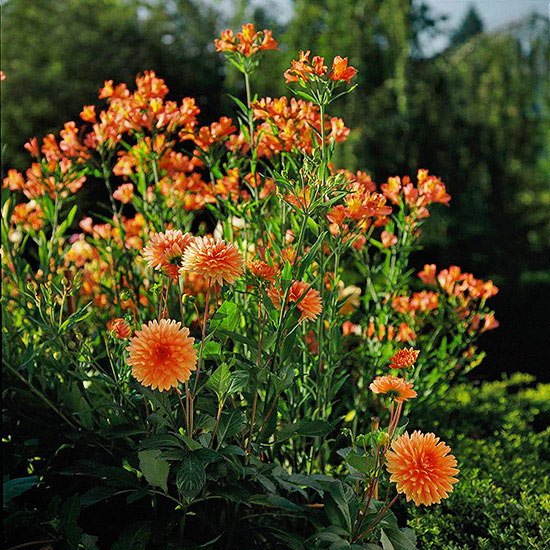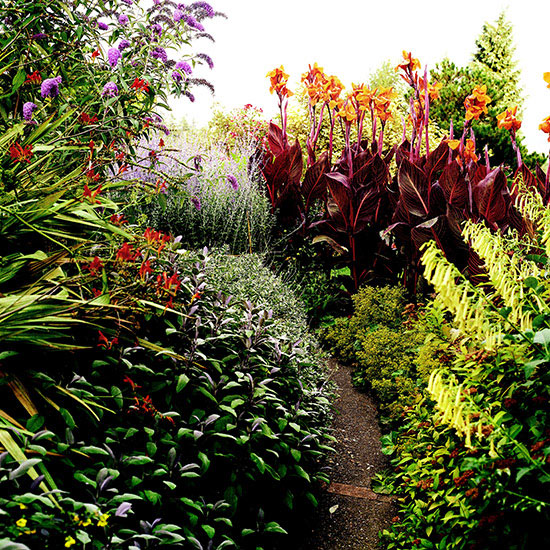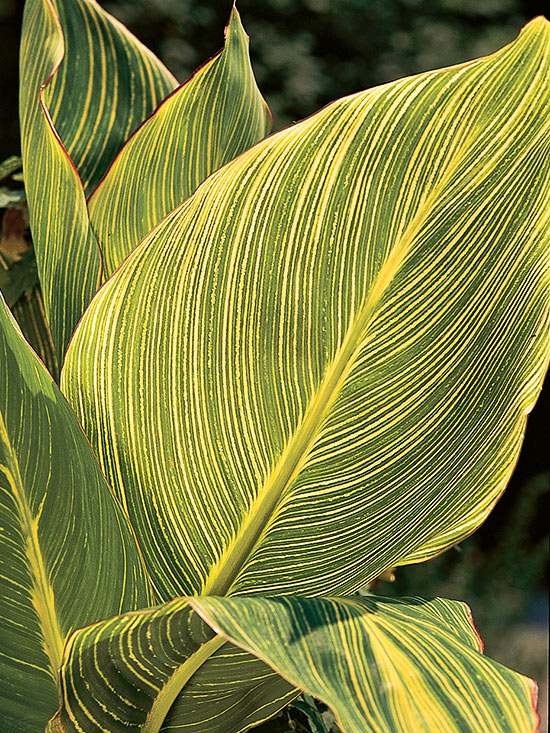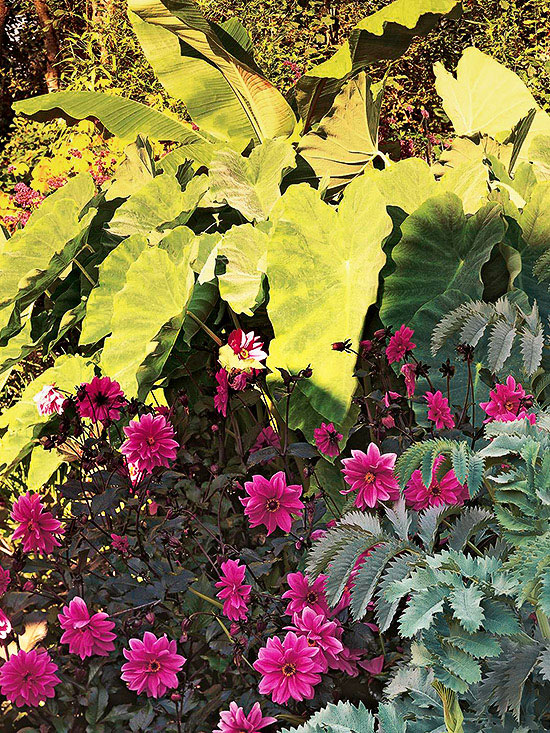





 The mai tai colors of Dahlia'Simplicity' and Alstroemeria 'Beatrix' give this garden tropical flair.
The mai tai colors of Dahlia'Simplicity' and Alstroemeria 'Beatrix' give this garden tropical flair.
Dramatic structure and colors tip a garden's design into the tropical zone. The tiger-stripe foliage of a canna, and the vibrant lime, pink, and purple of coleus leaves, put the fun back in gardening. Victorian-era gardens popularized summer beds where circus-color menageries of exotic plants romped. Tropical plants seem at home in any climate. When the sun heats up, their growth accelerates into junglelike luxuriance.
See the best tropical flowers for your patio.
continue reading below Towering cannas (rear right)bring a jungle atmosphere tothe garden. Other tropicaltouches include cape fuchsia,nicotiana, and cinquefoil.Butterfly bush (rear left)helps develop a sense ofenclosure.
Towering cannas (rear right)bring a jungle atmosphere tothe garden. Other tropicaltouches include cape fuchsia,nicotiana, and cinquefoil.Butterfly bush (rear left)helps develop a sense ofenclosure.
Savvy gardeners value many tropical natives for their flamboyant foliage. Coleus, an annual in most North American climates, offers hundreds of varieties in shades of kiwi green, magenta, gold, burgundy, and white. Sun-tolerant varieties with thicker leaves have recently debuted.
Cannas, grown from rhizomes, sport bold leaves often striped in gold and topped with bright red, orange, yellow, or pink flowers. Another tuberous plant, caladium, develops arrowhead-shape leaves in pink, red, and green. Angel-wing and Rex begonias also add speckled and striped foliage to the tropical palette. Elephant's ear (Colocasia) contributes massive, lofty leaves in deep purple, gold, or green.
The unusual blooms of flowering plants from the tropics of Africa and South America, when planted in borders or containers, form delicate contrasts against flamboyant leaves. Abutilon's inverted bell flowers attract hummingbirds by the droves, as do the trumpet blooms of Phygelius (cape fuchsia). Brugmansia, or angel's trumpet, boasts dramatic flowers with a sweet fragrance. Overwinter these torrid-zone plants indoors.
Hot oranges, reds, and yellows for painting tropical palettes come from nasturtium and Mexican sunflower (Tithonia). Annual and perennial salvias supply blues, reds, and purples. Summer bulbs that also fit the tropical motif include crocosmia, dahlia, and Eucomis, or pineapple lily.
Related Feature: Creating Colorful Foliage Gardens
 'Bengal Tiger' canna (also knownas 'Praetoria') provides thegiant leaves that create a tropical feeling, as well as apricot-orange flowers.
'Bengal Tiger' canna (also knownas 'Praetoria') provides thegiant leaves that create a tropical feeling, as well as apricot-orange flowers.
The best-kept secret about tropical gardens is that not all the players need hail from exotic locales. Think large and dramatic foliage plus bold color, and you'll end up with hundreds of plants that are growable in your garden all year despite long, cold winters. Glossy ground covers with a lush habit include hardy arums and asarums. You can't beat Acanthus, Gunnera, or Rheum for leafy architecture, and all these perennials survive cold winters. The imposing leaves of catalpa and magnolia trees have a tropical feel, yet they're quite hardy. Dutchman's pipe, trumpet vine, and hardy passionflower display a junglelike vigor, and the vast bamboo and fern families number several cold-hardy species in their ranks.
Among succulents, sedum, sempervivum, yucca, and prickly pear cactus can weather cold winters. Melianthus, a fringed silvery shrub from mountainous Africa, ranks high on the list of tropical wannabes. It has an imposing structure and a crowd-pleasing color that makes it an outstanding companion plant. New Zealand flax (Phormium) has multicolor straplike leaves that make good focal points in tropical-theme borders. Some Phormium hybrids are hardy to Zone 7.
Related Feature: Wild at Heart Container Garden Plan
 Melianthus major, or honey bush, poses with golden elephant's earand 'Fascination' dahlia.
Melianthus major, or honey bush, poses with golden elephant's earand 'Fascination' dahlia.
After the final frost in spring, plant showy annuals to fill gaps in a tropical-look garden. Use castor bean, plume poppy, and cleome for striking height or form. Annual vines grown from seed, such as purple hyacinth bean, scarlet runner bean, or black-eyed Susan vine, rise up quickly and entwine structures in junglelike lushness.
Houseplants that have languished on the windowsill all winter can also be exported to add color to tropical borders. Hibiscus, palm, and others bring Hawaiian-shirt shades and shapes into temperate gardens. Make an easy fall transition to indoors by keeping a group of potted houseplants on the patio or deck, or gather them in a corner of the garden that offers late-day shade.
Related Feature: Free Garden and Landscape Plans
Copyright © www.100flowers.win Botanic Garden All Rights Reserved